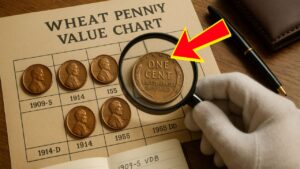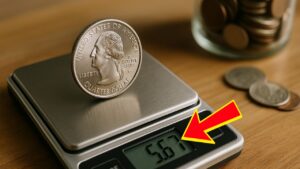If you are a coin collector or someone who recently found an old coin jar, the 1967 quarter may have caught your eye. While it may look like a regular coin, understanding its value today requires looking at its mint condition, silver content, rarity, and other factors.
In this detailed guide, we will break down everything you need to know about 1967 quarters, their current market value, and tips for maximizing their worth.
A Quick Overview of the 1967 Quarter
The 1967 quarter belongs to the Washington Quarter series, which was first introduced in 1932. The quarter features:
- Obverse Design: George Washington’s profile, designed by John Flanagan.
- Reverse Design: An eagle with outstretched wings perched on a bundle of arrows, above two olive branches.
- Composition: 40% silver and 60% copper. This makes the 1967 quarter highly valuable compared to post-1964 quarters, which are mostly copper-nickel.
- Mint Locations: Philadelphia (no mint mark), Denver (D), and San Francisco (S).
Notably, 1967 quarters were part of the final years of the silver quarter era, as silver content was removed in 1965. However, the 1967 quarters were clad coins, meaning they did not contain silver, but collectors still seek them due to their historic significance and certain rare varieties.
Understanding 1967 Quarter Value
The value of a 1967 quarter is influenced by several key factors:
- Mint Mark – Quarters from different mints may carry slightly different values.
- Condition – Coin condition is measured by grading, ranging from Poor (P) to Mint State (MS-70).
- Rarity – Any misprints, errors, or unique characteristics can significantly increase value.
- Silver Content – While 1967 quarters are clad and do not contain silver, earlier quarters (1964 and before) had silver content, which affects their collectibility.
Let’s dive into these aspects in detail.
1. Mint Mark and Its Importance
The mint mark is a small letter indicating the mint where the quarter was produced:
- No Mint Mark: Philadelphia Mint
- D: Denver Mint
- S: San Francisco Mint
While 1967 quarters are relatively common, certain mint marks can affect collector interest. For example, coins from the San Francisco Mint (S) were often minted in smaller quantities for circulation or proofs, making them more desirable for collectors.
2. Condition and Grading
The condition of a coin can drastically change its value. The standard grading scale includes:
| Grade | Description | Typical Value (USD) |
|---|---|---|
| Good (G) | Heavy wear; all major features visible | $0.25 – $0.50 |
| Very Fine (VF) | Moderate wear; details visible | $0.50 – $1.50 |
| Extremely Fine (EF/XF) | Light wear on high points | $1.50 – $3.00 |
| About Uncirculated (AU) | Slight traces of wear; almost mint condition | $3.00 – $5.00 |
| Mint State (MS-60 to MS-65) | No wear; full luster | $5.00 – $25.00+ |
Collectors often look for coins in Mint State, especially uncirculated proofs, as they can fetch a higher premium.
3. Common Errors and Varieties
Error coins can be surprisingly valuable. For 1967 quarters, common errors include:
- Double Die Errors – Letters or numbers appear doubled.
- Off-Center Strikes – The coin’s design is misaligned.
- Clipped Planchets – Part of the coin is missing due to minting error.
These errors are rare but can increase a quarter’s value from a few dollars to hundreds or even thousands depending on the severity and rarity of the error.
4. Collector Demand
Even though 1967 quarters were mass-produced, collector interest keeps their value above face value. Proof sets, uncirculated coins, and special editions command higher prices.
1967 Quarter Value by Mint and Condition
Here’s a detailed table showing the approximate current market value of 1967 quarters based on their mint mark and condition:
| Mint | Circulated Value | Uncirculated Value (MS-60 to MS-65) | Proof Value |
|---|---|---|---|
| Philadelphia (No Mint Mark) | $0.25 – $1.50 | $5.00 – $20.00 | $15.00 – $30.00 |
| Denver (D) | $0.25 – $1.50 | $5.00 – $20.00 | $15.00 – $30.00 |
| San Francisco (S) | $0.25 – $1.50 | $5.00 – $25.00 | $20.00 – $35.00 |
Key Notes:
- Proof coins were specially minted for collectors and typically have a mirror-like finish.
- Mint State coins are more valuable than circulated coins.
- Error coins can drastically exceed these listed values.
Tips for Determining the Value of Your 1967 Quarter
If you’ve found a 1967 quarter, here’s how to assess its value:
- Check the Mint Mark – Look under Washington’s neck to see if it has a “D” or “S”.
- Examine the Condition – Look for scratches, wear, or luster. Coins in better condition are more valuable.
- Look for Errors – Compare your coin with standard 1967 designs to identify potential errors.
- Consult a Professional Grader – For rare coins, a professional grading service can provide certification.
- Compare Market Prices – Use coin collector marketplaces and recent auction sales to get a realistic value.
Understanding Silver Value
Although 1967 quarters were no longer 90% silver, it’s worth noting the value of silver in earlier quarters:
- Pre-1965 Quarters: 90% silver content
- 1965-1970 Quarters: 40% silver in some special issues or collector sets
- Post-1970 Quarters: Mostly copper-nickel
Collectors sometimes compare 1967 quarters to earlier silver quarters to understand market interest, especially for proof sets and special editions that can include 40% silver content.
How to Sell a 1967 Quarter
If you decide to sell your 1967 quarter, consider the following:
- Sell to a Coin Dealer: Offers quick cash but might give slightly lower prices.
- Sell Online: Auction sites allow you to reach a broader audience and potentially higher prices.
- Hold for Appreciation: Rare coins and error coins often increase in value over time.
- Get Certified: Professional grading can increase value and attract serious collectors.
The 1967 quarter is more than just a small piece of change—it’s a collectible item with historical significance. Its value today depends on the mint mark, condition, proof status, and presence of any minting errors.
While most circulated quarters are modestly above face value, uncirculated and proof coins can fetch between $5 to $35 or more. By carefully examining your coin, consulting grading services, and understanding the collector market, you can accurately determine the worth of your 1967 quarter.
Even if your quarter seems ordinary, the combination of history, condition, and collector interest can make it a surprisingly valuable treasure.
FAQs About 1967 Quarter Value
Are all 1967 quarters valuable?
Not all 1967 quarters are highly valuable. Most circulated coins are worth slightly above face value, but uncirculated or proof coins, as well as error coins, can fetch significantly higher prices.
How can I tell if my 1967 quarter is a proof coin?
Proof coins have a mirror-like finish with sharp details. They are usually marked with an “S” mint mark from San Francisco and were made for collectors rather than general circulation.
Does a 1967 quarter contain silver?
No, 1967 quarters are clad coins, primarily composed of copper and nickel. However, they remain collectible due to rarity, condition, and special minting varieties.



